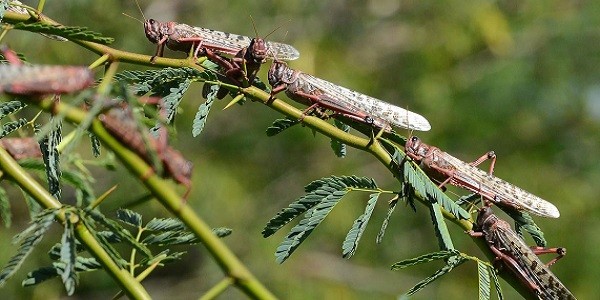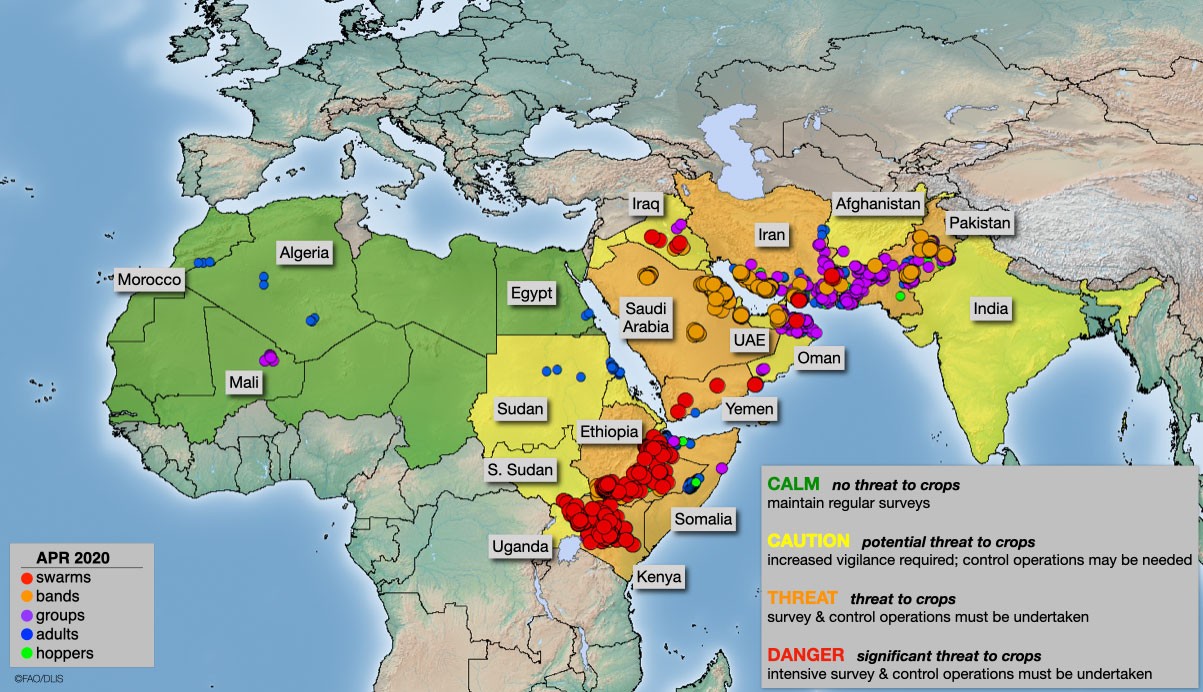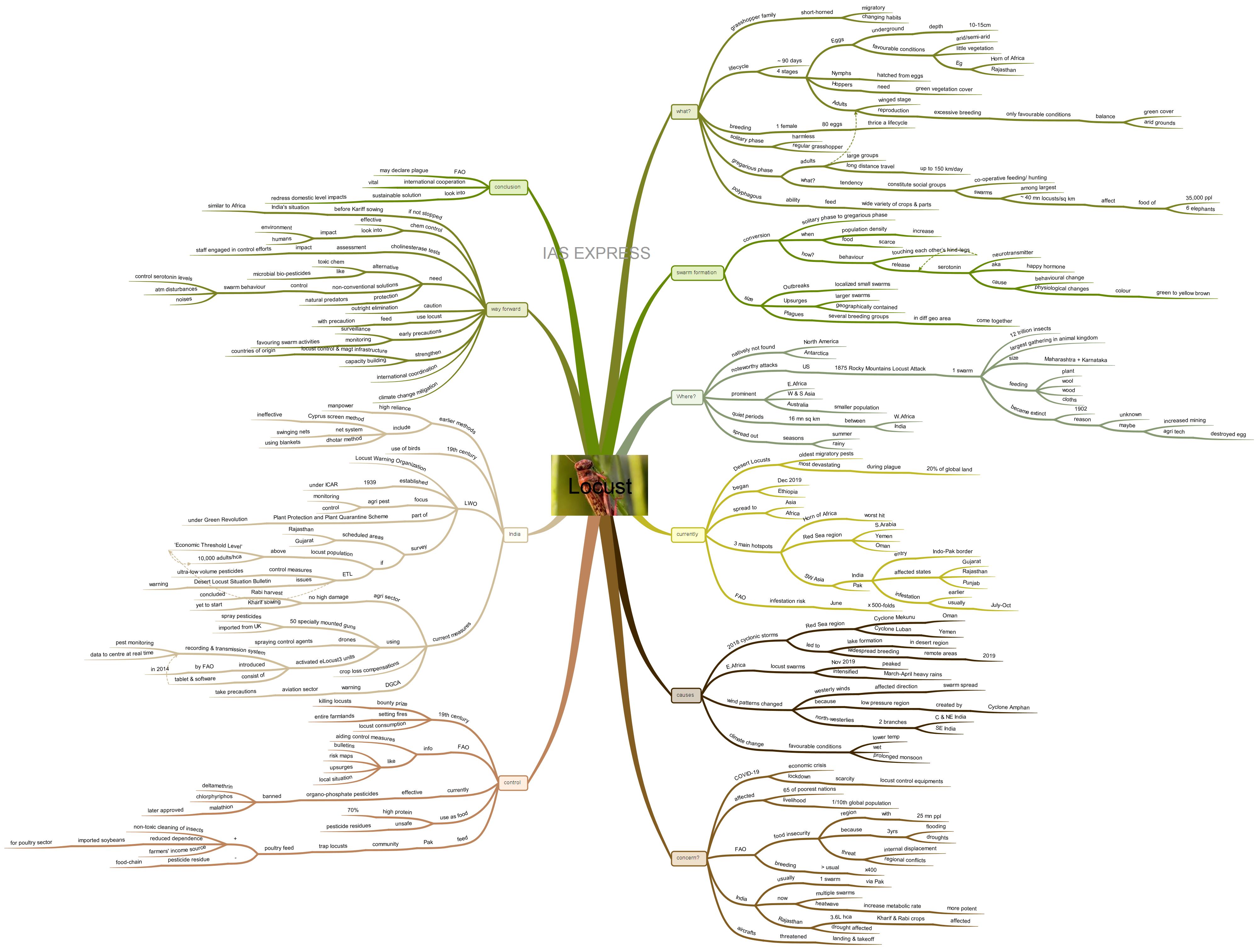Locust Attack – Causes, Concerns, Solutions

From Current Affairs Notes for UPSC » Editorials & In-depths » This topic
IAS EXPRESS Vs UPSC Prelims 2024: 85+ questions reflected
The Indian authorities recently issued a warning of possible widespread infestation of locusts in several states- stretching well into the southern region. India is only the latest to face the wrath of these devastating migratory pest which has been affecting several countries from December last year. The issue has raised serious concerns of food insecurity- especially in times of the global COVID-19 pandemic.
What are locusts?
- Locusts are large herbivorous insects of the grasshopper family. They are short-horned grasshoppers that differ from the regular grasshoppers in that they exhibit migratory behaviour and changing habits.
- Locusts’ lifecycle of approximately 90 days is composed of 4 stages:
- Eggs: buried in the ground at depths of 10 to 15cm. This stage requires arid or semi-arid conditions without much vegetation cover. Hence breeding is mostly confined to places like Horn of Africa and Rajasthan and doesn’t occur in areas like Indo-Gangetic Plains, the Godavari or Cauvery Delta further south.
- Nymphs: individuals hatched from the eggs
- Hoppers: require green vegetation cover for further development
- Adults: this is a winged stage that goes on to reproduce
- Large scale breeding in locusts can happen only when the conditions are favourable- with the right balance of green cover and arid grounds.
- The locusts are generally in a ‘solitary phase’ when they are mostly harmless and appear like a regular grasshopper.
- However, this can turn into a ‘gregarious phase’ where the adults come together in large groups and travel long distances.
- In ecology, gregariousness is the tendency to constitute social groups for cooperative feeding/ hunting. Locust swarms are known to be among the largest in the animal kingdom.
- They are polyphagous– meaning they can feed on a wide variety of crops and also on different parts of the crops like leaves, flowers, etc.
- The insects can cover large distances- sometimes up to 150 km in a single day.
- These swarms can contain as many as 40 million locusts in a square kilometre.
How do such swarms form?
- Swarm formation starts with the conversion of the locusts from their solitary phase to the gregarious phase.
- This conversion occurs when the population density increases and the food starts to become scarce.
- At this time, the locusts start touching each other’s hind-legs. This behaviour releases a neurotransmitter called serotonin or the happy hormone (also present in humans).
- This can occur in a group with as few as 10 individuals but in a tight enough space.
- The serotonin release and build-up not only causes behavioural changes but also physiological changes like the change in colour from green to the characteristic yellowish-brown.
- The groups can be of different sizes:
- Outbreaks: these are localized small swarms
- Upsurges: these are larger swarms but are still geographically contained.
- Plagues: when several breeding groups that are separated geographically come together, they form a plague.
Where are they found?
- North America and Antarctica are the only continents where locusts are not found natively.
- The USA did have historical cases of locust attacks in the 19th The 1875 Rocky Mountains Locust Attack is the most noteworthy with over 12 trillion insects in one swarm- the largest such gathering of any animal on the planet. The swarm had a combined area of Maharashtra and Karnataka. It blocked out the sky and fed on everything ranging from plants and wool to wooden handles and clothes off people’s backs.
- However, the Rocky Mountain Locusts became extinct in 1902 for unclear reasons. Suspected causes include increased mining activity, development of agricultural technology which led to more ploughing, irrigation and digging up of grounds, etc. which destroyed the eggs.
- Locusts have been recorded in China, Greece, Rome, Syria, etc.
- Currently, locust populations are prominent in Eastern Africa, Western and Southern Asia with smaller populations in the Australian region.
- During the quiet periods, they are found in a 16 million square kilometre area between West Africa and India.
- They spread out to other regions mainly in the summer and rainy seasons.
What is happening now?
- The current issue involves the immature stages of the Desert Locust– the oldest migratory pests and the most devastating among all locust species that affects 20% of the world’s land during a plague.
- The outbreak began in December 2019 in Ethiopia. It has now spread to more than a dozen countries in Africa and Asia.
- According to the UN’s FAO, there are 3 main hotspots- The Horn of Africa, which is the worst hit, the Red Sea region and South-West Asia.
- Somalia and Ethiopia are experiencing the worst infestation in 25 years. Ethiopia’s Rift Valley is one of the affected regions. Iran and Kenya are facing their worst locust crisis in 7 decades.
- According to FAO, the infestation poses a serious risk of multiplying 500-folds by June this year in the absence of international help to curb the swarm.
- In the Red Sea region, affected countries include Saudi Arabia, Yemen and Oman. Iran, India and Pakistan are the affected nations in the South-west Asian region.
- Countries like Somalia and Pakistan have declared an emergency. In Pakistan, the Punjab province, which is the most important agricultural region of the country, is the worst hit.

In India:
- The insects entered India via the Indo-Pakistan border area and have affected the states of Gujarat, Rajasthan and Punjab.
- The current infestation is significant as it has come earlier in the year than usual (July to October).
- They have even entered urban spaces of Rajasthan, Madhya Pradesh and Maharashtra.

What are the causes of the current outbreak?
- The outbreak has been attributed to the 2018 cyclonic storms in the Red Sea region that led to lake formation in normally desert regions. The Cyclone Mekunu struck Oman while the Cyclone Luban affected Yemen.
- This change facilitated wide-spread breeding in the remote areas throughout 2019. In the unmonitored and uncontrolled scenario like this, locusts can increase 20-folds in just the first generation.
- Locusts swarm peaked in November 2019 in Eastern Africa. Since the start of 2020, swarms built up in Iran and Pakistan.
- This was further aided by March-April heavy rains in East Africa.
- There have been changes in the wind patterns (Westerly Winds) because of the low-pressure region created by Cyclone Amphan which has aided these passive fliers.
- The 2 branches of north-westerlies- split from the winds entering India to the north of Western Ghats- have dictated the direction of the swarm’s spread- one branch towards central and north-eastern India and the other towards south-east India.
- Experts are blaming climate change for the intensity and erratic nature of the infestation. This is because lower temperature and wetter conditions favour spreading of the infestation.
- India experienced a prolonged monsoon- especially in locust-prone states like Rajasthan- which gave the insects enough time to increase exponentially.
Why are locusts a cause for concern?
- The world is already reeling from the impacts of COVID-19 and the accompanying economic crisis.
- Desert Locusts affect 65 of the poorest nations in the world. They endanger the livelihood of 1/10th of the global population. They cause large-scale damage to crop and pasture lands.
- The FAO has warned of unprecedented food insecurity in a region housing 25 million people already affected by 3 consecutive years of flooding and droughts. This may aggravate the internal displacement issues and regional conflict.
- The UN body also reported that the locusts are breeding 400 times their usual rate due to favourable conditions.
- Many countries are facing a scarcity of locust control equipment like sprayers, pesticides, vehicles, etc. because of lockdown restrictions.
- Usually, only a single swarm crosses over from Pakistan to India. This time, there have been multiple swarms crossing over into India.
- In Rajasthan, 3.6 lakh hectares of Kharif and Rabi crops have been seriously affected. The farmers in these states were already reeling under drought conditions. The insect has attacked crops of cumin, mustard and wheat.
- With favourable conditions in the near future, the FAO has predicted that swarms could reach as far as Bihar and Odisha.
- A swarm of 40 million locusts in 1 square kilometre can consume crops equivalent to the food of 35,000 people or 6 elephants.
- The locusts can breed exponentially with a single female capable of laying 80 eggs, thrice during its life cycle.
- Due to food scarcity in Rajasthan (harvest is mostly finished), the swarms have been entering urban spaces too.
- The northern states are going through a heat-wave spell. Increased temperature is known to increase their metabolic rate- making them more dangerous to crops. Also, water scarcity won’t affect them much as they store energy in the form of lipids containing water. This means that as the average global temperature rises, such swarms become more potent.
- The swarms are posing a threat to aircraft- especially at the landing and take-off phases (as the swarms are found at lower altitudes). Passing through a swarm may cause ingestion of the insects via air intake ports of the aeroplanes.

How are locust infestations controlled?
- Locust infestations have been around since biblical times. In the 19th century, various measures like issuing bounty prize for killing locusts, setting large fires to entire farmlands, consumption of locusts as delicacies, etc. have been used.
- The FAO provides various information, for aiding control measures, such as bulletins, risk maps, information on upsurges and local situations, etc.
- Currently, one of the most effective ways to control such large swarms is through use of organo-phosphate pesticides. This will also enable control in a relatively short period. Examples include lambdacyhalothirn, deltamethrin, fipronil, chlorpyriphos and malathion.
- The centre had banned the use of deltamethrin, chlorphyriphos and malathion- though malathion was later approved for locust control.
- These are sprayed aerially on the night resting places of the insects.
- Small swarms can be effectively controlled using natural predators like wasps, birds and reptiles.
- There have been suggestions for the use of locusts as food- such as in Yemen in 2019. They are one of the cheapest and richest protein sources. Example: while soybean has a protein content of 45%, locusts have 70%. However, it has been deemed unsafe over concerns of possible pesticide residues.
- The locusts could be used as feed for poultry industry or fisheries. Recently, Pakistan employed community members to trap locusts for being processed into poultry feed. On the plus side:
- Farmers are earning an income from trapping the pests.
- Large-scale clearing of the insects without the use of toxic pesticides and hence avoiding environmental degradation.
- Pakistan is reducing its dependence on imported soybeans as a protein source for its poultry sector.
On the negative side, there is the possibility of entry of pesticide residues (from earlier control activities) into the food chain.
What is the locust control scenario in India?
Locust Infestations in India
- Locusts have found mention in ancient Indian literature like the Mahabharat and 400 BCE Sanskrit literature.
- India has nearly 2 centuries worth of experience in locust control. The Bombay Locust was a major pest in India in the 18th to 19th century. Serious incidents occurred in 1812, 1821, 1843-44, 1863, 1869, 1878, 1889-92 and 1896-97.
- However, no major plague has been reported from India since the last plague in 1908.
Early Control Methods
- Earlier methods of control in India included the Cyprus screen method (largely ineffective), net system (swinging nets in the fields to capture the insects) and the dhotar method (use of blankets to trap resting insects). These methods relied heavily on manpower.
- In the late 19th century, authorities relied on birds like kites, crows, storks, starlings, peafowls, and rosy starling birds to achieve greater success.
Locust Warning Organization
- The Locust Warning Organization was established in the colonial times itself (1939) under the ICAR, to specifically deal with the monitoring and control of this agricultural pest.
- The LWO is a part of Plant Protection and Plant Quarantine Scheme under the Green Revolution. It is headquartered in Jodhpur.
- The LWO regularly surveys scheduled areas in Rajasthan and Gujarat to assess if the locust population has risen over the ‘Economic Threshold Level’ or 10,000 adults in a hectare. The surveys are stepped up during the May-November period when the locust activity peaks.
- In case of populations exceeding ETL, the LWO undertakes immediate control measures. Its standard operations include the use of ULV (ultra-low volume) pesticide applications- where a small volume of concentrated pesticide is applied to the affected area.
- It also issues Desert Locust Situation Bulletinto warn stakeholders about the locust situation.
Current Measures
- The agricultural sector didn’t face much damage as the Rabi harvest has already concluded and the Kharif sowing is yet to commence on large scale.
- India is making use of 50 specially mounted guns for spraying pesticides on the locust infected areas. More such guns are to arrive from the UK.
- The authorities are also making use of drones for spraying control agents.
- The authorities are using the activated eLocust3 units to aid the survey. The eLocust3 is a recording and transmission system for pest monitoring in croplands. It was introduced by FAO in 2014 and consists of a tablet and software that enables field staff to record and transmit data to the centres in real-time.
- The governments have been looking into crop loss compensations. The Rajasthan Government has announced a 31 crore INR compensation after assessment of loss in 4 districts.
- The DGCA has advised the aviation sector to take precaution against locust swarms in their operation. The air traffic controllers are to warn pilots of locust swarms’ presence and the pilots have been required to report swarms’ sightings. They have been warned against using wipers as it might aggravate the situation. They have also been asked to appropriately close possible air-intake ports.
Way forward?
- If the breeding becomes coterminous with Kharif crop in India, the situation of African farmers cultivating wheat, maize and sorghum may be replicated in India.
- While chemical control is the most sure-fire way to tackle the locusts, there is a need to look into the environmental impact of the usage.
- These pesticides also affect people. The LWO conducts cholinesterase tests to check for adverse effects of the pesticides among the staff engaged in control efforts. However, there is a need to look for such effects among the general public too- especially the vulnerable sections like the farming community.
- There is a need to develop alternatives to toxic chemical pesticides. Solutions such as microbial bio-pesticides (like the fungus-based Green Muscle) can be explored.
- Non-conventional solutions need to be considered too. Studies have indicated that swarming behaviour can be curbed by controlling the serotonin levels. Other swarm management strategies being proposed including the creation of atmospheric disturbances and noises to break up swarms.
- One of the best long-term strategies includes maintaining a healthy population of natural predators. Protection of native birds like Myna and Crows can help. But this must be coupled with the elimination of pesticide use- to prevent poisoning of the avian populations.
- There is a need for caution while eliminating ‘pests’. A case in point is China’s elimination of the ‘4 pests’– rats, flies, mosquitoes and sparrows in 1958. The loss of sparrows led to the unintended consequence of disturbed equilibrium and multiplication of locust swarms. In response, China developed a ‘duck army’ to control this swarm.
- The locusts can be used as feed for livestock with appropriate precautions.
- The best method is to prevent such outbreaks.
- Surveillance and monitoring are key components. These need to be complemented with monitoring of factors that contribute to swarming activity- such as wind speed and movements.
- Capacity building and strengthening of locust control and management infrastructure at countries of origin.
- There is a need for international coordination as locust infestation is a trans-boundary issue.
- Like in the case of many issues in the current times, there is a dire need for climate change mitigation.
Conclusion
The 2019-20 locust outbreak is expected to be declared as a ‘plague’ by the FAO if it worsens any further. The issue has come in at a very unfortunate time when the SARS CoV 2 is making its rounds and the climate change effects have started to become increasingly prominent. The compounding of problems like food insecurity and economic downturn are expected to hit several parts of the world. Though India has been one of the better-prepared countries, the issue can only be controlled with international cooperation. Meanwhile, the country can look at a more sustainable solution to redress the domestic level impacts.
Practice Question for Mains
Discuss the reasons behind the severity of the 2019-20 Locust Attacks. How can India improve its handling of such infestations? (250 words)
If you like this post, please share your feedback in the comments section below so that we will upload more posts like this.


